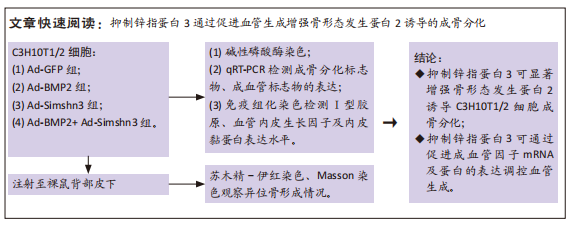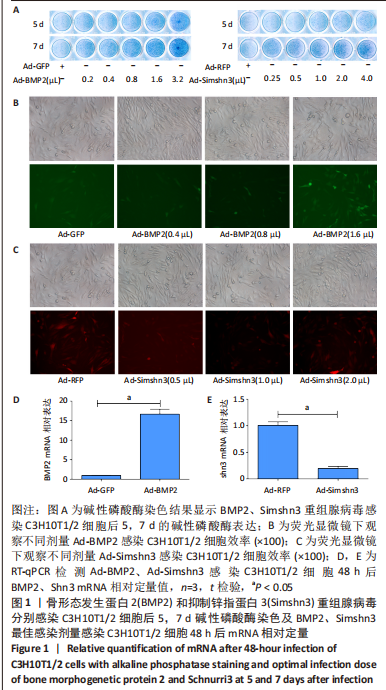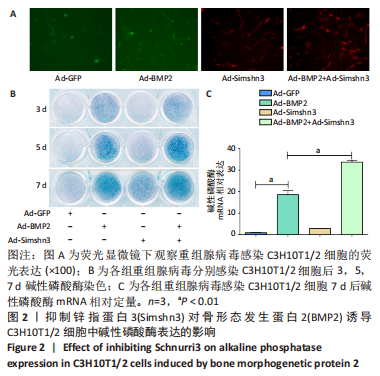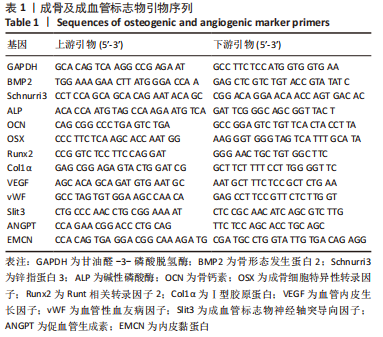[1] KOSTENUIK P, MIRZA FM. Fracture healing physiology and the quest for therapies for delayed healing and nonunion. J Orthop Res. 2017;35(2):213-223.
[2] 王钊,闫石.应用Masquelet技术治疗大段骨缺损减少自体骨用量的可能性[J].中国组织工程研究,2020,24(24):3862-3869.
[3] 彭鑫,彭中华,谭奇超,等.骨组织工程学中复合支架及其应用研究进展[J].医学综述, 2022,28(13):2548-2554.
[4] 程永刚,宋晓阳,刘浩,等.股骨头缺血性坏死髋关节外科脱位入路打压植骨术后截骨端不愈合1例[J].中国骨与关节损伤杂志,2021,36(12):1340-1341.
[5] KATAGIRI T, WATABE T. Bone Morphogenetic Proteins. Cold Spring Harb Perspect Biol. 2016; 8(6):a021899.
[6] PARK SH, KWON JS, LEE BS, et al. BMP2-modified injectable hydrogel for osteogenic differentiation of human periodontal ligament stem cells. Sci Rep. 2017;7(1):6603.
[7] 从凯,李善龙,王飞,等.骨形态发生蛋白2,7治疗骨不连的效果评价[J].中国组织工程研究,2020,24(26):4243-4250.
[8] SHEIKH Z, JAVAID MA, HAMDAN N, et al. Bone Regeneration Using Bone Morphogenetic Proteins and Various Biomaterial Carriers. Materials (Basel). 2015;8(4):1778-1816.
[9] PENG Y, KANG Q, CHENG H, et al. Transcriptional characterization of bone morphogenetic proteins (BMPs)-mediated osteogenic signaling. J Cell Biochem. 2003;90(6):1149-1165.
[10] ZHANG L, LUO Q, SHU Y, et al. Transcriptomic landscape regulated by the 14 types of bone morphogenetic proteins (BMPs) in lineage commitment and differentiation of mesenchymal stem cells (MSCs). Genes Dis. 2019;6(3):258-275.
[11] RAHMAN MS, AKHTAR N, JAMIL HM, et al. TGF-β/BMP signaling and other molecular events: regulation of osteoblastogenesis and bone formation. Bone Res. 2015;3:15005.
[12] RAUNER M, BASCHANT U, ROETTO A, et al. Transferrin receptor 2 controls bone mass and pathological bone formation via BMP and Wnt signaling. Nat Metab. 2019;1(1):111-124.
[13] CAHILL KS, CHI JH, DAY A, et al. Prevalence, complications, and hospital charges associated with use of bone-morphogenetic proteins in spinal fusion procedures. JAMA. 2009;302(1):58-66.
[14] FU M, BLACKSHEAR PJ. RNA-binding proteins in immune regulation: a focus on CCCH zinc finger proteins. Nat Rev Immunol. 2017;17(2):130-143.
[15] MACKEH R, MARR AK, FADDA A,et al. C2H2-Type Zinc Finger Proteins: Evolutionarily Old and New Partners of the Nuclear Hormone Receptors. Nucl Recept Signal. 2018;15: 1550762918801071.
[16] JIN W, TAKAGI T, KANESASHI SN, et al. Schnurri-2 controls BMP-dependent adipogenesis via interaction with Smad proteins. Dev Cell. 2006;10(4):461-471.
[17] CASSANDRI M, SMIRNOV A, NOVELLI F, et al. Zinc-finger proteins in health and disease. Cell Death Discov. 2017;3:17071.
[18] WEI S, ZHANG L, ZHOU X, et al. Emerging roles of zinc finger proteins in regulating adipogenesis. Cell Mol Life Sci. 2013;70(23):4569-4584.
[19] UPADHYAY A, MOSS-TAYLOR L, KIM MJ, et al. TGF-β Family Signaling in Drosophila. Cold Spring Harb Perspect Biol. 2017;9(9):a022152.
[20] STROEBELE E, ERIVES A. Integration of Orthogonal Signaling by the Notch and Dpp Pathways in Drosophila. Genetics. 2016;203(1):219-240.
[21] AFFOLTER M, BASLER K. The Decapentaplegic morphogen gradient: from pattern formation to growth regulation. Nat Rev Genet. 2007;8(9):663-674.
[22] VAN BORTLE K, PETERSON AJ, TAKENAKA N, et al. CTCF-dependent co-localization of canonical Smad signaling factors at architectural protein binding sites in D. melanogaster. Cell Cycle. 2015;14(16):2677-2687.
[23] 孙鹏宇,张艳玲,荆玉明,等.腺病毒滴度不同测定方法比较[J].南方医科大学学报, 2011,31(2):234-238.
[24] CHEN L, JIANG W, HUANG J, et al. Insulin-like growth factor 2 (IGF-2) potentiates BMP-9-induced osteogenic differentiation and bone formation. J Bone Miner Res. 2010;25(11):2447-2459.
[25] 任明诗,丁羽,李子涵,等.成骨细胞与破骨细胞相互调节作用的研究进展[J].中国药理学通报,2022,38(6):822-827.
[26] 王布雨,张勇,李飞非,等.骨软骨缺损修复中骨形态发生蛋白2 的作用与应用[J].中国组织工程研究,2023,27(20):3259-3265.
[27] HO SS, VOLLMER NL, REFAAT MI, et al. Bone Morphogenetic Protein-2 Promotes Human Mesenchymal Stem Cell Survival and Resultant Bone Formation When Entrapped in Photocrosslinked Alginate Hydrogels. Adv Healthc Mater. 2016;5(19):2501-2509.
[28] JAMES AW, LACHAUD G, SHEN J, et al. A Review of the Clinical Side Effects of Bone Morphogenetic Protein-2. Tissue Eng Part B Rev. 2016;22(4):284-297.
[29] KRISHNAN L, PRIDDY LB, ESANCY C, et al. Delivery vehicle effects on bone regeneration and heterotopic ossification induced by high dose BMP-2. Acta Biomater. 2017;49:101-112.
[30] ZHANG C, MENG C, GUAN D, et al. BMP2 and VEGF165 transfection to bone marrow stromal stem cells regulate osteogenic potential in vitro. Medicine (Baltimore). 2018;97(5):e9787.
[31] MCBRIDE-GAGYI SH, MCKENZIE JA, BUETTMANN EG, et al. Bmp2 conditional knockout in osteoblasts and endothelial cells does not impair bone formation after injury or mechanical loading in adult mice. Bone. 2015;81:533-543.
[32] MANNION RJ, NOWITZKE AM, WOOD MJ. Promoting fusion in minimally invasive lumbar interbody stabilization with low-dose bone morphogenic protein-2--but what is the cost? Spine J. 2011;11(6):527-533.
[33] RAZZOUK S, SARKIS R. BMP-2: biological challenges to its clinical use. N Y State Dent J. 2012; 78(5):37-39.
[34] YANG YS, XIE J, WANG D, et al. Bone-targeting AAV-mediated silencing of Schnurri-3 prevents bone loss in osteoporosis. Nat Commun. 2019;10(1):2958.
[35] JONES DC, WEIN MN, OUKKA M, et al. Regulation of adult bone mass by the zinc finger adapter protein Schnurri-3. Science. 2006;312(5777):1223-1227.
[36] DIOMEDE F, MARCONI GD, FONTICOLI L, et al. Functional Relationship between Osteogenesis and Angiogenesis in Tissue Regeneration. Int J Mol Sci. 2020;21(9):3242.
[37] SARAN U, GEMINI PIPERNI S, CHATTERJEE S. Role of angiogenesis in bone repair. Arch Biochem Biophys. 2014;561:109-117.
[38] SHARMA S, XUE Y, XING Z, et al. Adenoviral mediated mono delivery of BMP2 is superior to the combined delivery of BMP2 and VEGFA in bone regeneration in a critical-sized rat calvarial bone defect. Bone Rep. 2019;10:100205.
[39] SHARMA S, SAPKOTA D, XUE Y, et al. Delivery of VEGFA in bone marrow stromal cells seeded in copolymer scaffold enhances angiogenesis, but is inadequate for osteogenesis as compared with the dual delivery of VEGFA and BMP2 in a subcutaneous mouse model. Stem Cell Res Ther. 2018;9(1):23.
[40] SHARMA S, SAPKOTA D, XUE Y, et al. Adenoviral Mediated Expression of BMP2 by Bone Marrow Stromal Cells Cultured in 3D Copolymer Scaffolds Enhances Bone Formation. PLoS One. 2016; 11(1):e0147507.
[41] KUSUMBE AP, RAMASAMY SK, ADAMS RH. Coupling of angiogenesis and osteogenesis by a specific vessel subtype in bone. Nature. 2014;507(7492):323-328.
[42] ZHANG J, PAN J, JING W. Motivating role of type H vessels in bone regeneration. Cell Prolif. 2020;53(9):e12874.
[43] XU R, YALLOWITZ A, QIN A, et al. Targeting skeletal endothelium to ameliorate bone loss. Nat Med. 2018;24(6):823-833.
|








